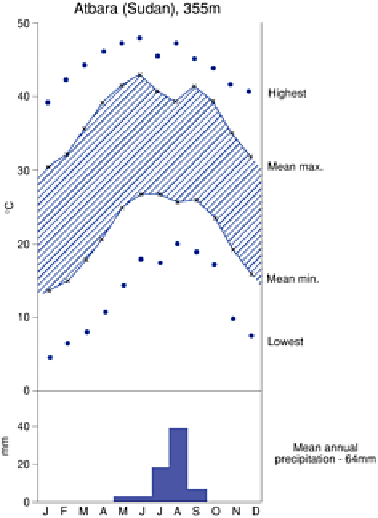Environmental Engineering Reference
In-Depth Information
the Red Sea coast of north-west Saudi Arabia, for example, show a mean over a twenty-
three-year period of 25·3 mm. Only eight
Figure 27.3
Climatic data for Atbara, Sudan.
years received more than the mean figure. It has been said that, for deserts, average
rainfall is the total that never falls, though that is an exaggeration.
In some of the subtropical high-pressure belts additional factors reduce the likelihood
of rain. On the western coasts of the Sahara, the Kalahari and the Atacama deserts, cold
ocean currents flow offshore. They cool the air and make it even more stable. Mist and
fog may be frequent but rain is rare. One of the driest places in the world is Arica in the
Atacama desert of Chile. Years have elapsed between rainstorms and even then only a
few millimetres may fall. Conditions there are similar to those in other coastal deserts
near a cold ocean current but in addition the prevailing winds blow from the south-east.
To reach the Chilean and Peruvian coasts, they must descend the main mountain barrier
of the Andes, some 5000 m, which further emphasizes stability and dryness. The result of
all these factors acting against the mechanisms of rainfall generation is to produce one of
the driest parts of the planet (Plate 27.1).
Moving away from the core areas of the dry lands, we encounter increased moisture
availability. The areas polewards have been included in the chapter on Mediterranean
environments (Chapter 26), but equatorwards we gradually change from true desert,
through semi-arid environments to the savanna zone with deciduous woodlands and
eventually into the monsoonal and tropical rain forests. The tropical rain forest will be

